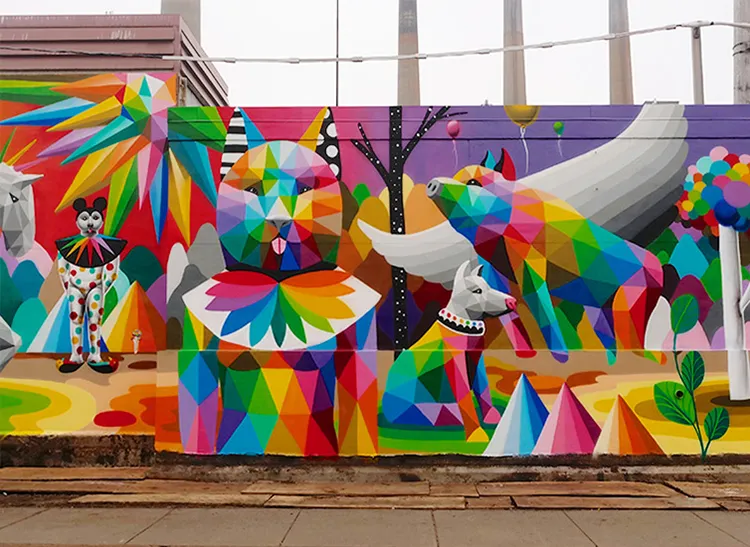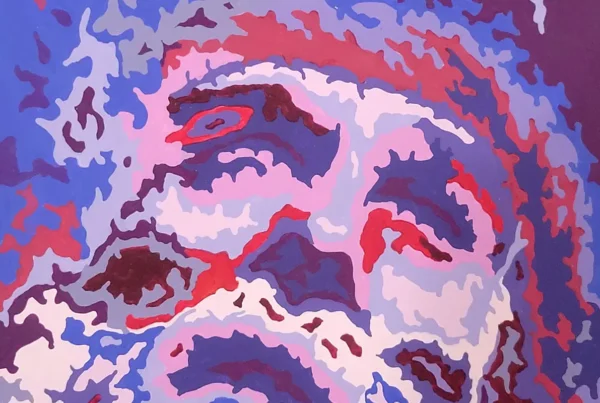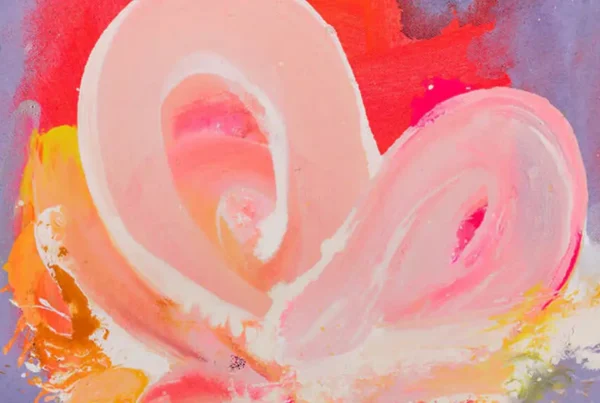From Graffiti Beginnings to Artistic Renown
Born Óscar San Miguel Erice in Santander, Spain, on November 19, 1980, Okuda San Miguel’s journey into the art world began in the unlikeliest of places: the gritty urban landscapes of abandoned factories and railways. In 1996, as a teenager, he discovered graffiti, a medium that captivated his imagination and provided a canvas for his early artistic experiments. These early forays into street art laid the foundation for his distinctive style, characterized by vibrant colors and geometric patterns. To further hone his craft, Okuda studied Fine Arts at the Complutense University of Madrid, where he expanded his artistic knowledge and skills. Through his transformation of forgotten spaces into dynamic visual experiences, Okuda began to carve out a unique niche in the art world.
Okuda’s evolution from a street artist to a globally recognized figure was fueled by his relentless experimentation and broad range of influences. Drawing inspiration from surrealism and pop art, as well as the diverse cultures encountered during his extensive travels, he developed a signature aesthetic. His use of bright, geometric shapes juxtaposed against grey, organic forms became a visual language through which he explored profound themes. This distinctive style allowed Okuda to address complex subjects such as existentialism and the deceptive freedoms promised by capitalism, making his work both visually striking and intellectually stimulating.
In the early stages of his career, Okuda participated in several significant projects that expanded his reach and artistic maturity. In 2009 he started working with IAM, which lead to other exhibitions in major cities such as New York, Berlin, London, and Paris. This exposure to a wider audience helped refine his style and deepen the emotional resonance of his work. Another pivotal moment came in 2015 when he transformed the interior of the Santa Barbara church in Llanera, Asturias, into the vibrant Kaos Temple, a project that garnered international acclaim and cemented his status as a transformative artist.

Okuda San Miguel: A Fusion of Surrealism and Pop Art
Okuda San Miguel’s artistic style is a vivid amalgamation of geometric patterns and surreal themes, a blend that has become his hallmark. His work often features a striking contrast between bright, bold colors and organic, grey tones, creating a dynamic visual tension that captures the viewer’s attention. This unique aesthetic emerged from a combination of diverse influences, including surrealism, pop art, and the various cultures he encountered during his travels around the world. Each of these elements contributed to the evolution of his style, resulting in a body of work that is both visually arresting and thought-provoking.
At the core of Okuda’s art is a deep engagement with existential themes and modern societal issues. He uses his vibrant, geometric compositions to explore contradictions inherent in contemporary life, such as the tension between modernity and tradition, or the illusion of freedom within capitalist societies. These themes are woven into his work, prompting viewers to reflect on their own existence and the broader world. Okuda’s art serves as a catalyst for dialogue, encouraging audiences to question and reassess their perspectives on life and society.
A notable project that exemplifies Okuda’s approach is the transformation of the Santa Barbara church into the Kaos Temple. This project was a collaboration with a group of donors who had converted the abandoned church into a skate park and invited Okuda to reimagine its interior. By infusing the sacred space with his signature geometric patterns and vibrant colors, Okuda created a surreal, otherworldly environment that fused contemporary art with traditional architecture. The Kaos Temple project not only showcased Okuda’s artistic vision but also demonstrated the potential of art to reanimate and repurpose forgotten spaces, turning them into sites of new cultural significance.

Cultural Inspirations and Global Influence
Traveling extensively, Okuda San Miguel draws profound inspiration from the myriad cultures he encounters, each journey adding new dimensions to his art. His travels introduce him to different color palettes, symbols, and artistic traditions, which he seamlessly integrates into his own work. This continuous process of learning and adaptation allows Okuda to create pieces that are rich in cultural references and diverse influences, making his art resonate with a global audience. The interplay of light, color, and local architectural styles from various regions around the world enriches his geometric and surreal compositions.
One of Okuda’s most notable collaborations was with the fashion brand Desigual, where he created a mural for their Herald Square store in New York City. This mural, completed in December 2019, featured a reimagined Statue of Liberty rendered in Okuda’s vibrant, geometric style. The piece symbolized freedom and creativity, themes central to both the brand’s identity and Okuda’s artistic philosophy. Such collaborations allow Okuda to bring his art into public spaces, making it accessible to a wider audience and demonstrating the versatility and appeal of his style.
In addition to his collaborations with major brands, Okuda has also engaged in large-scale projects that push the boundaries of traditional art forms. One such project was Kaos Garden, an immersive experience that debuted at Amnesia Ibiza and later traveled to Miami and New York. Inspired by Hieronymus Bosch’s “The Garden of Earthly Delights,” Kaos Garden combined visual art, music, and interactive elements to create a surrealist fantasy world. This project was significant not only for its innovative blend of different artistic mediums but also for its ability to create a holistic sensory experience, further expanding the possibilities of how art can be experienced and enjoyed.

Okuda San Miguel: Aspirations and Artistic Philosophy
Looking to the future, Okuda San Miguel aspires to continue expanding the scope and scale of his projects, exploring new ideas and pushing the boundaries of his creativity. His goal is to take on larger buildings and more ambitious projects around the world, including in countries he has yet to visit, such as various Asian nations. Having already left his mark in places like Australia and the United States, Okuda aims to further develop his artistic vision and continue making a meaningful impact through his work.
Success for Okuda is not merely measured by fame or financial gain but by the freedom to create and the ability to inspire others through his art. He values the positive influence his work can have on people’s lives and strives to maintain a balance between personal expression and public engagement. Traveling the world, collaborating with other artists, and continuously evolving his style are all aspects of Okuda’s definition of success. Ultimately, he seeks to live a life true to his values and artistic philosophy, constantly challenging himself and his audience to see the world from new perspectives.
Okuda’s artistic journey is a testament to the power of creativity and the transformative potential of art. From his early days as a graffiti artist in Santander to his current status as a globally recognized figure, he has consistently pushed the boundaries of what art can achieve. His work not only beautifies public spaces but also provokes thought and dialogue, encouraging viewers to reflect on deeper existential themes and societal issues. As he continues to grow and evolve as an artist, Okuda San Miguel remains committed to his vision of creating art that inspires, challenges, and transcends cultural boundaries.






